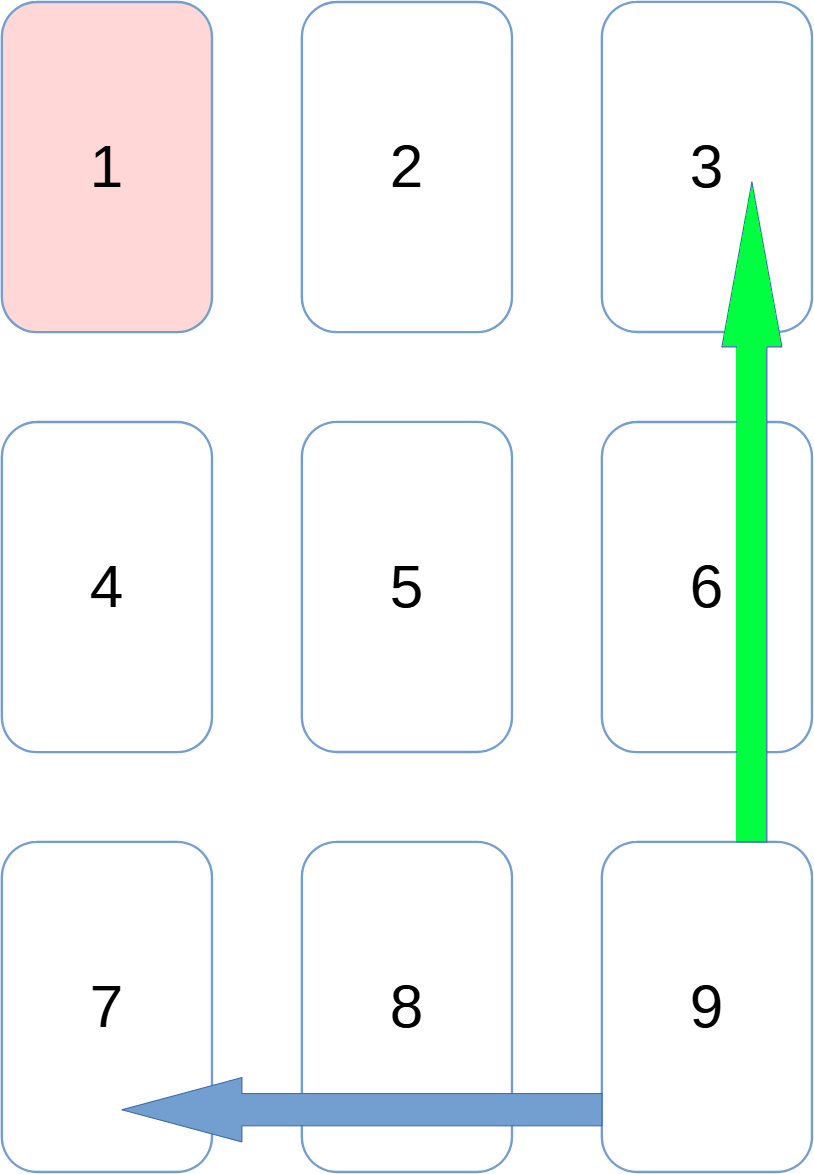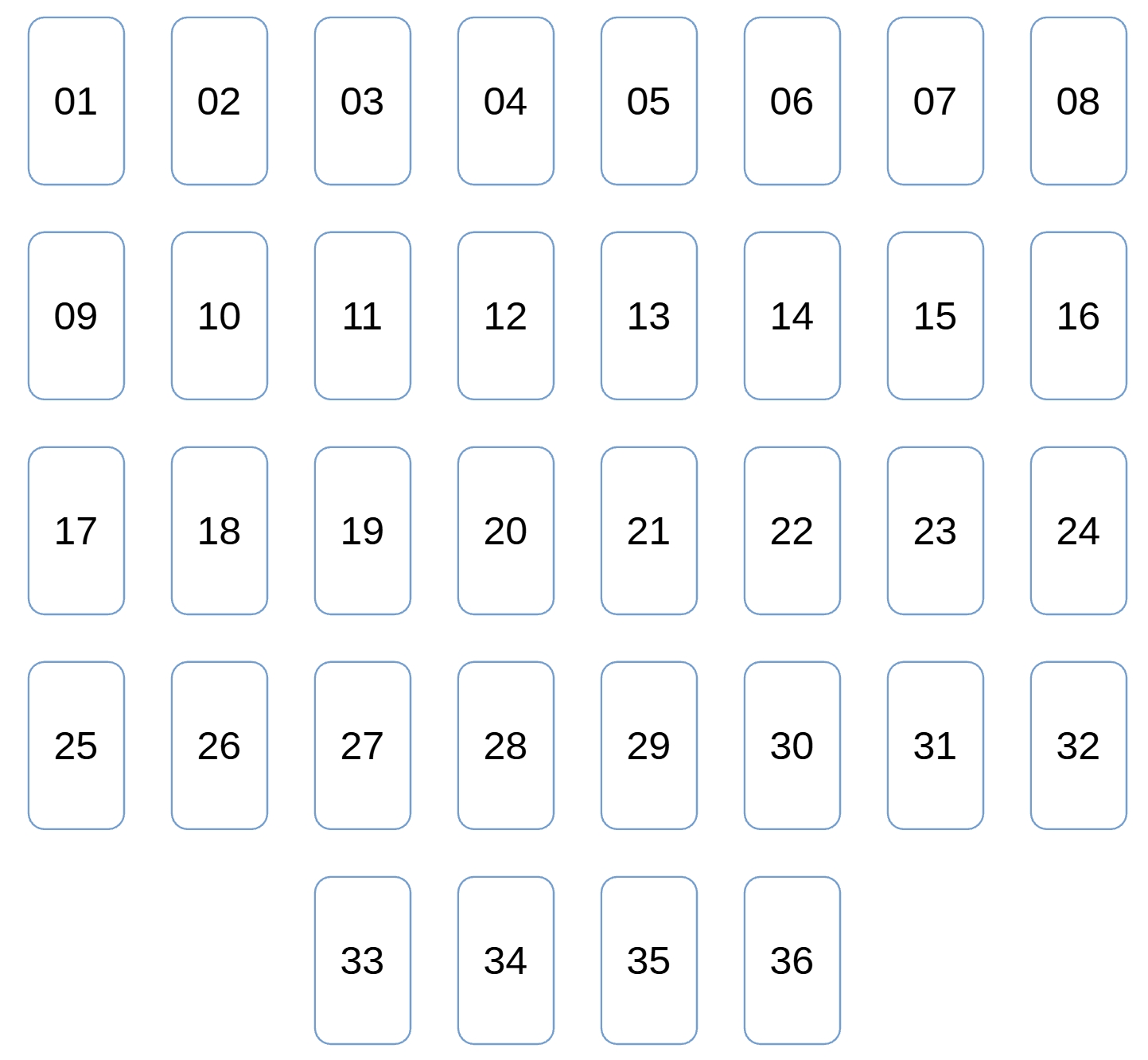Spreads for the Lenormand Cards
- Jump to: Advisory 9x9
- Jump to: The Grand Tableau
The classic Lenormand card Spread is a Tableau layout, but string layouts can also be employed. Cards are always read upright inside of Spreads, and always "paired" (to indicate the subject and its expression), never individually. Be mindful that the Lenormand always answers questions literally, and could sometimes even be referring to the namesake of the cards title, so grokking context is crucial!
It is claimed that anything touched by a person will absorb a little of that persons aura. If this is what you believe, then it is a good idea to "clear" newly acquired decks before their first use, and to cursorily clear the cards between readings. Whether or not you permit a querent to touch your cards is a personal choice (it opens the cards to the possibility of being damaged or soiled), but allowing physical contact, if even just for pointing or pile cutting, is encouraged for absorptive reasons.
As with other predictive card systems, final shuffles should be blind overhand shuffles. When you read a Spread, it is the spot where a card is placed in the Spread that is of importance. Therefore, before you lay a Spread, you must be mindful about what each spot in the particular Spread is designated to be representing, so that the cards filling each spot can be subconsciously selected to reveal a valid answer. Most querents appreciate if you begin by first reading their Spread as a flowing overview paragraph, before explicating individual card details.
Individual Lenormand cards incorporate multiple related meanings, which are extremely dependent upon the context of both the questions circumstance and the cards position within a Spread (proximity and direction from the card under scrutiny to the other cards within the Spread will temper the scrutinized cards meaning). Modern Lenormand scholars recommend that the Man card should be used to indicate the "Querent", and the Woman card to indicate the "Significant", regardless of the actual genders of the persons being referenced.
This petite tableau Spread uses a 3-card pairing, rather than the conventional 2-card pairing technique. The vectors used during interpretation also differ from those commonly used in more conventional exploratory petite tableaus. Use this Spread when you want to allow the cards to pick their own theme about which they want to impart some advice.
Begin the Spread by thoroughly overhand shuffling the deck face down. Now start peeling cards off from the top of this stack consecutively, turning each card face up to build a 9 card square tableau of three rows of three cards (see the below illustration for card laydown order). If any cards are reversed, spin them so they are upright. The first card laid down will be the Significator, and unless there is a overriding need to specifically choose and place this card into the Spread ahead of the deck shuffle, the card should be allowed to appear of its own accord as a part of the Theme the Spread desires to discuss.

In a triple pairing the first card is the Subject, and the remaining two the modifying Expressions.
Ruminate upon Significator card 1 and the relating overall "Theme" of the reading. The Theme is revealed through perimeter cards 1-2-3, then 3-6-9, then 9-8-7, and finally 7-4-1. 
The topical "Past" is stated through cards 1-2-3, then 1-4-7,  topical "Present" through cards 2-5-8, then 4-5-6,
topical "Present" through cards 2-5-8, then 4-5-6,  and topical "Future" through cards 9-6-3, then 9-8-7.
and topical "Future" through cards 9-6-3, then 9-8-7. 
This Past/Present/Future information can be skipped, as it is presented mostly as a clarifier of the Theme.
The "Advice" about the Significator and its theme that the deck wishes to impart, is revealed through cards 1-5-9, then 7-5-3. 
This classic self examination Spread uses every card in the deck, and can be rather formidable to read. The Spread reveals in detail all of the factors that are currently affecting the life of the querent. Traditionally the Querent card was the Man card for a male seeker, and the Woman card for a female seeker; but today most readers only use the "Man" card for all querents. The card traditionally selected to indicate an intimate Significant was the opposite gender of the Querent card; but today most readers only use the "Woman" card for all significants.
Begin the Spread by thoroughly overhand shuffling the deck face down. Now start peeling cards off from the top of this stack consecutively, turning each card face up to build a 36 card tableau of four rows of eight cards, followed by one centered row of four cards (see the below illustration for card laydown order). If any cards are reversed, spin them so they are upright.

Cards in positions 01 and 32, and 08 and 25 are treated as two Pairs, which summarize the context surrounding the querents current life situation.
The cards in positions 12, 13, 20, and 21 summarize the core issue affecting the querents current life situation.
Now locate the Querent (nowadays Man) card, as this is the center around which everything else orbits. From a broad overhead view, all the cards in the tableau are seen as Subject cards, referencing individual segments of the querents life. Each of these segments can be individually scrutinized, even though they may not currently be imposing much influence upon the querent. The Grand Tableau uses 2-card subject/expression Pairings, so all 8 of the cards (there can be less) surrounding the Subject card under scrutiny are treated as modifying Expressions.
Current influence of a life segment card upon the Querent card is determined by both its Vector and Distance from the Querent card. Querent card physical location in respect to the Spreads center will thus color the reading (possibly even obscuring potential futures). Cards on the horizontal vector to the left of the Querent card are Past influences, falling further into the past as distance increases. Cards on the horizontal vector to the right of the Querent card are a forecast of potential Future influences, occurring farther into the future as distance increases.
Cards on the vertical vector below the Querent card are Subconscious murmurings, that become quieter as distance increases. Cards on the vertical vector above the Querent card are Conscious ideas and thoughts, which become less solidified as distance increases.
Cards on the two merging diagonal vectors to the left side of the Querent card reveal notable factors that led up to the current moment. Cards on the two diverging diagonal vectors to the right side of the Querent card are a forecast of potential paths that lead away from the current moment.
All content appearing on this webpage is FREE for personal use,
being either expressly created or previously posted as anonymously accessible public on the Internet.
No - Signup chicanery, Tracking, Cookies, JavaScript, Merchandising, or Donation solicitations.